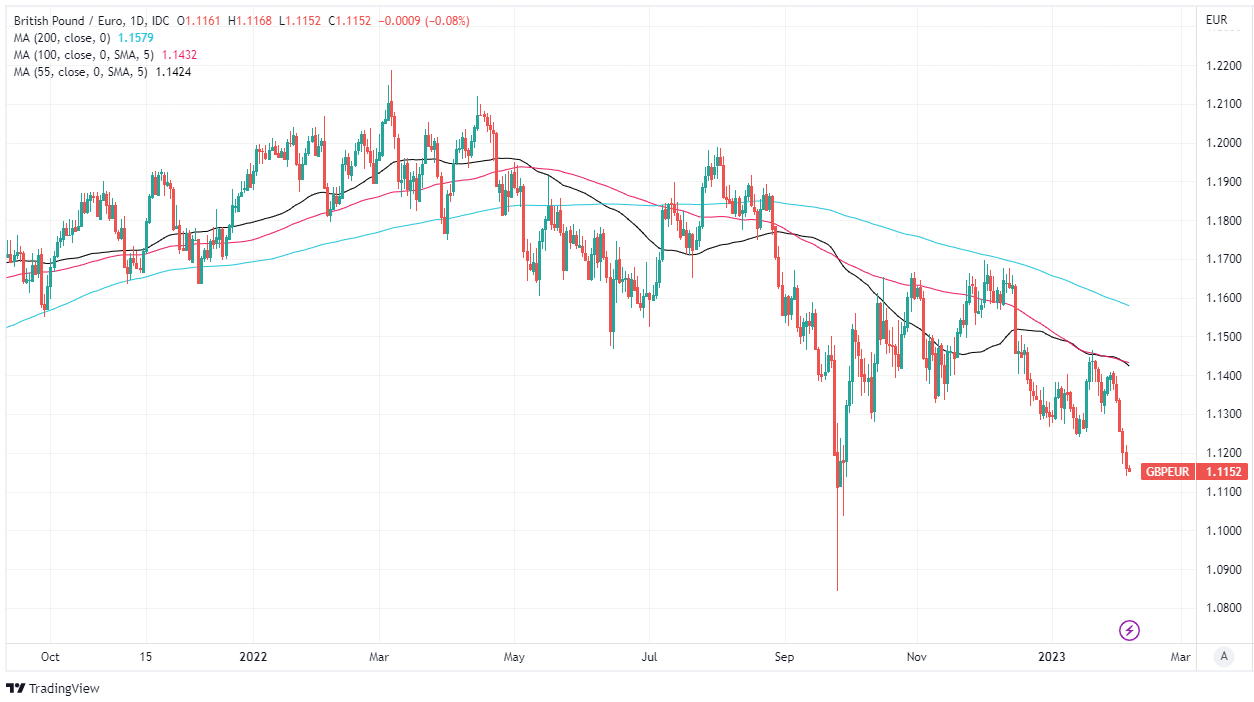Pound Constrained against Euro Amidst Central Bank Divergence
- Written by: James Skinner
- GBP/EUR upside likely limited to near 1.12
- Risks suppression near 1.11 or even below
- BoE speeches in focus ahead of GDP data

Image © Adobe Images
The Pound to Euro exchange rate has been hobbled by a tentatively crystallising risk of divergence between Bank of England (BoE) and European Central Bank (ECB) interest rates, which could keep Sterling under wraps below 1.12 this week and risks encouraging a probe below 1.11.
Sterling enters the new week near multi-month lows after unravelling for five days on the bounce but with the heaviest losses seen amid and in the wake of back-to-back policy announcements from the BoE and ECB.
"We have seen a turning of the corner but it's very early days and the risks are very large, and it's really that I think shapes where we go from here," BoE Governor Andrew Bailey said in Thursday's press conference following a decision to raise interest rates 50 basis points.
"So if those risks emerge and if we continue to get overshoots as we've seen, in particular wage data and particularly wage settlement data and services inflation, then we will have to respond to that because that will be evidence that these risks are crystallising," he added.
The BoE was non-committal last week when it came to the prospect of further increases in Bank Rate, which was raised to 4% on the day, but also acknowledged the "significant" risk that borrowing costs could have to rise further in the months ahead.
Above: Pound to Euro rate shown at daily intervals. Click image for closer inspection.
Compare Currency Exchange Rates
Find out how much you could save on your international transfer
Estimated saving compared to high street banks:
£25.00
Free • No obligation • Takes 2 minutes
Meanwhile, the European Central Bank was resolute in confirming that continental interest rates are sure to rise further in March and are likely to be lifted again in the months thereafter, albeit in still-undetermined increments.
"We are certainly not there now, nor will we be in March, given that we will rely on underlying inflation indicators and pressure that we see very, very clearly nowadays," President Christine Lagarde said on Thursday.
"What will happen next, as I said earlier on, is going to be a factor of how much more ground we need to cover, and there will be ground to cover most likely, but it will be data-dependent," she added.
President Lagarde said on Thursday that a half percent increase in interest rate is all but a done deal for March and was clear that ECB interest rates are likely to rise further in the months after, though potentially in smaller increments.
The combination of policy outlooks saw the Pound to Euro rate come under pressure and could be likely to keep it suppressed throughout the week ahead when members of the BoE Monetary Policy Committee are scheduled to hit the speaking circuit en masse ahead of Friday's final quarter GDP data.
Above: Financial model-derived estimates of probable trading ranges for selected currency pairs this week. Source Pound Sterling Live. These ranges were updated after initial publication to correct for data entry errors. (If you are looking to protect or boost your international payment budget you could consider securing today's rate for use in the future, or set an order for your ideal rate when it is achieved, more information can be found here.)
"Updated guidance heavily signalled that the Bank is approaching the end of the tightening cycle. Consequently, we no longer expect a May hike, and see the final 25bp hike in March, taking the terminal rate to 4.25%," says Abbas Khan, an economist at Barclays.
The big risk for the Pound to Euro rate this week is that Friday's GDP data comes in weaker than expected with confirmation of the UK economy slipped into recession last quarter, which would risk prompting financial markets to revise their expectations for Bank Rate up ahead.
Whether or not a recession is ongoing remains a close call as the consensus among economists is that GDP growth likely stalled at 0% in the final quarter owing to an anticipated -0.3% reading for December GDP.
"While a recession in the first half of the year remains likely, we now expect the economy to start growing again in Q3 2023, two quarters earlier than we previously anticipated, due to the sharp fall in wholesale energy prices," says Samuel Tombs, chief UK economist at Pantheon Macroeconomics.
"We also see upside risk to the MPC's unemployment rate forecast this year, given that it finalised its labour supply projections just before the ONS released data showing that immigration recently has been stronger than previously estimated. On balance, then, we still think that 4% will be the peak for Bank Rate," Tombs and colleagues write in a Monday research briefing.
Compare Currency Exchange Rates
Find out how much you could save on your international transfer
Estimated saving compared to high street banks:
£25.00
Free • No obligation • Takes 2 minutes






